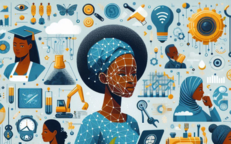Embracing Robotics To Forge A Path Toward Sustainable Forestry

This is the 5th post in a blog series to be published in 2024 by the APET Secretariat on behalf of the AU High-Level Panel on Emerging Technologies (APET)
Africa’s forests, covering over 624 million hectares (ha), account for 20.6% of the continent’s land area and 15.6% of the global forest cover. These forests are central to the African Union’s (AU) Agenda 2063, the Blueprint for the continent’s development. This vision portrays a continent thriving through the sustainable management of its resources, fostering long-term growth.[1] A key element of this development agenda is the sustainable forestry management framework introduced in 2020, designed to guide AU Member States in implementing viable practices and developing policies for forest management.[2]
Forests are crucial for millions of Africans, underpinning key sectors such as energy, forestry, agriculture, tourism, and water across many AU Member States. On a continental level, forests are essential for maintaining ecosystem stability and quality, providing vital ecological services locally and globally. These services include biodiversity conservation, soil preservation, and water resource management. Known for their rich biodiversity, African woodlands are also vital in regulating the global climate by acting as carbon sinks, absorbing significant amounts of carbon dioxide from the atmosphere. Moreover, trees have deep spiritual and cultural significance for Africans, transcending their aesthetic value to become sacred symbols embedded within their beliefs and identities.
Despite their pivotal role in the continent’s development, African forests are diminishing rapidly, with approximately 4 million hectares lost each year, a rate that is twice that of other continents.[3] The primary drivers of deforestation in Africa include the expansion of agriculture, charcoal production, commercial logging, and encroachment for settlements.[4] This ongoing loss has dire consequences, including ecosystem damage, biodiversity loss, and habitat disruption, which are critical for both planetary health and human well-being. These impacts also compromise essential functions such as nutrient-rich food availability, climate regulation, and water provision.
Across the continent, AU Member States are proactively addressing deforestation and safeguarding their critical forest ecosystems through various initiatives. One approach involves empowering local communities reliant on forests for their livelihoods, granting them land rights and involving them in forest management decisions to promote sustainable practices. Additionally, the implementation of Reducing Emissions from Deforestation and Forest Degradation (REDD+) programmes offers financial incentives to countries that conserve their forests, thereby fostering forest protection and providing alternative income sources for local communities.[5] Furthermore, many AU Member States are expanding their network of protected areas, establishing national parks and reserves to limit logging and development within these designated zones, thus directly safeguarding specific forest ecosystems.
Despite the importance of these efforts, challenges persist, including difficulties in enforcement due to vast forested areas and limited resources, the complex balancing act between forest conservation and economic development, and the need for comprehensive data on forest cover, threats, and biodiversity for effective management, which traditional methods may struggle to provide due to their time-consuming and costly nature. Traditional methods may struggle to meet these needs, as they are often time-consuming and costly.[6]
The African Union High-Level Panel on Emerging Technologies (APET) proposes incorporating robotics into forest management strategies and plans, which can significantly enhance the ability of AU Member States to protect and effectively utilise their forest resources. This integration is expected to play a crucial role in preserving biodiversity, mitigating climate change impacts, and fostering socioeconomic progress within the region. By leveraging robotics, AU Member States can strengthen their capacity to conserve and sustainably utilise forest resources, thereby contributing to biodiversity conservation, climate change mitigation, and socio-economic development.
APET notes that a number of AU Member States are increasingly turning to robotics to achieve sustainable forestry practices, thereby augmenting traditional methods with innovative technologies. In Ghana, for instance, a pioneering programme employs drones equipped with Light Detection and Ranging (LiDAR) technology to generate detailed 3D maps of forests, providing valuable data on tree height, canopy cover, and individual tree growth. This information aids foresters in assessing ecosystem health and making informed decisions regarding harvesting and replanting initiatives. Meanwhile, in South Africa, efforts are underway to develop autonomous robots designed for precise tree felling, which minimises damage to surrounding vegetation and promotes a more sustainable approach to harvesting. Kenya, on the other hand, is deploying anti-poaching robots equipped with cameras and sensors to patrol national reserves autonomously, effectively combating illegal logging and wildlife poaching while enabling rangers to focus on strategic interventions.[7]
While manual labour remains vital to reforestation efforts, several African countries are leveraging drones to achieve notable successes. For example, in Kenya, Kenya Flying Labs partnered with World Vision Kenya to utilise drones for reforestation in Tana River County.[8] These drones excel in rapidly seeding vast areas with native tree species, including terrain inaccessible to manual planting methods. This project exemplifies the efficiency and expansive reach drones bring to reforestation endeavours. Moreover, equipped with multispectral cameras, these drones monitor the health and survival rates of newly planted trees, assisting in the refinement of replanting strategies for greater success. Drones also play a critical role in post-planting management by applying nutrients and fertilisers to young trees, which is especially beneficial in remote areas with limited ground access.[9] These innovative approaches indicate progress towards more efficient and sustainable forestry practices.
Despite the potential benefits, challenges remain, including high initial costs, infrastructure demands, and the need for specialised technical expertise. APET notes a slow uptake of robotics in Africa, attributing it to two main factors.[10] Firstly, there's a lack of awareness about the benefits that robotics can offer to the forestry sector, which affects perceptions and career opportunities. Secondly, there are challenges in the effective management and maintenance of deployed technology.[11] Similarly, drone utilisation in African reforestation faces hurdles like limited technical expertise, weather dependence, and battery limitations. Overcoming these challenges is crucial for maximising the impact of drones in enhancing reforestation efforts continent-wide.[12]
To enhance the adoption of these technologies, APET urges AU Member States to address the challenges associated with the use of robotics and drones in sustainable forestry through improved knowledge dissemination and capacity building.[13] The AU could initiate educational programmes at national level to enhance the understanding of the advantages and applications of robotics and drones in forestry management. These efforts might include workshops, training sessions, and platforms for sharing knowledge and best practices among decision-makers, policymakers, forest managers, and local communities. Additionally, collaborative campaigns with media outlets and educational institutions can raise public awareness about the positive impact of these technologies, thereby fostering acceptance and encouraging investment. Skills development programmes are also important to equip local communities with the technical expertise needed to operate and maintain robotics and drones, thus facilitating their widespread adoption and creating new job opportunities.
Furthermore, APET suggests that AU Member States need to tackle investment and infrastructure challenges, including financial barriers, by engaging in national and international resource mobilisation efforts. By collaborating with development partners and the private sector, African governments could establish financing mechanisms aimed at subsidising the initial costs of acquiring robotics and drone technology. This approach would facilitate broader access to these innovative technologies, promoting their adoption and integration into sustainable development initiatives across the continent. Encouraging public-private partnerships to invest in infrastructure development in remote areas, such as establishing charging stations for drones and enhancing rural internet connectivity, is also vital.
Additionally, technology transfer initiatives could facilitate partnerships with developed nations to transfer expertise and potentially manufacture or assemble robotics and drones within Africa, reducing reliance on costly imports and promoting self-sufficiency.[14] APET strongly recommends that AU Member States increase funding mechanisms to support research and development initiatives. These initiatives should focus on creating affordable and adaptable robotics and drone solutions specifically designed for the unique challenges of African forestry. It is also vital for these countries to collaborate on research projects and share best practices in using these technologies for sustainable forestry management. Additionally, establishing regional innovation hubs dedicated to the development and testing of new forestry technologies will promote collaboration among scientists, engineers, and forestry professionals, thereby driving innovation and progress in the field.
In conclusion, APET calls on AU Member States, particularly policy and decision-makers, and legislators, to implement supporting policies, legislation, and laws that reduce bureaucratic hurdles and provide incentives such as tax breaks to businesses investing in advanced forest management technologies. Developing policies with targeted financial support for the deployment of robotics could prove beneficial in harnessing the full potential of these technologies. Importantly, overcoming obstacles and maximising the benefits of robotics in Africa will likely hinge on the provision of financial assistance and technical support to research and development organisations working on the adoption and adaptation of robotics. By implementing these recommendations and fostering an enabling environment, AU Member States can unlock the transformative potential of robotics in sustainable forestry management, driving economic growth and environmental conservation across the continent.
Featured Bloggers – APET Secretariat
Aggrey Ambali
Justina Dugbazah - The Sahara Institute
Barbara Glover
Bhekani Mbuli
Chifundo Kungade
Nhlawulo Shikwambane
[1] https://afforum.org/oldaff/sites/default/files/English/English_235.pdf
[2] http://www.xinhuanet.com/english/2019-05/21/c_138075136.htm
[3] https://earth.org/deforestation-in-africa/
[4] https://earth.org/deforestation-in-africa/
[5] https://au.int/sites/default/files/documents/41959-doc-CC_Strategy_and_Action_Plan_2022-2032_08_02_23_Single_Print_Ready.pdf
[6] https://portals.iucn.org/library/sites/library/files/documents/2020-034-En.pdf
[7] https://www.fao.org/e-agriculture/news/african-union-embraces-drones-technology-agriculture
[8] https://www.linkedin.com/posts/world-vision-kenya_using-drones-to-boost-tree-cover-and-restore-activity-7025739945726124033--ZYb/?trk=public_profile_like_view
[9] https://werobotics.org/blog/building-a-sustainable-ecosystem-collaborative-growth-in-tanzanias-drone-industry
[10] https://www.africanmining.co.za/2022/05/03/robotics-a-slow-adoption-and-yet-so-many-benefits/
[11] Bazargani, K.; Deemyad, T. Automation’s Impact on Agriculture: Opportunities, Challenges, and Economic Effects. Robotics 2024, 13, 33. https://doi.org/10.3390/robotics13020033
[12] Akinradewo, Opeoluwa & Oke, Ayodeji & Aigbavboa, Clinton. (2019). Assessment of the level of awareness of robotics and construction automation in South African.
[13] https://s3-eu-west-1.amazonaws.com/s3.sourceafrica.net/documents/120081/Drones-on-the-Horizon-Transforming-Africas.txt
[14] https://au.int/es/node/43160


